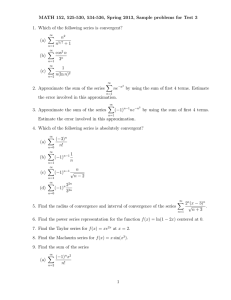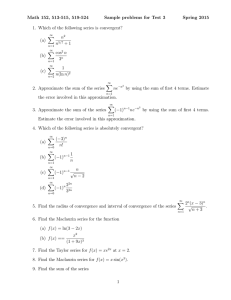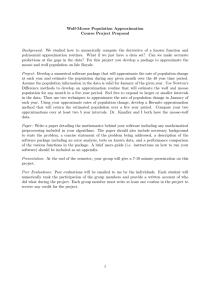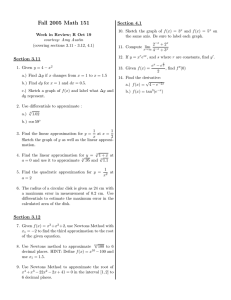Document 13342351
advertisement
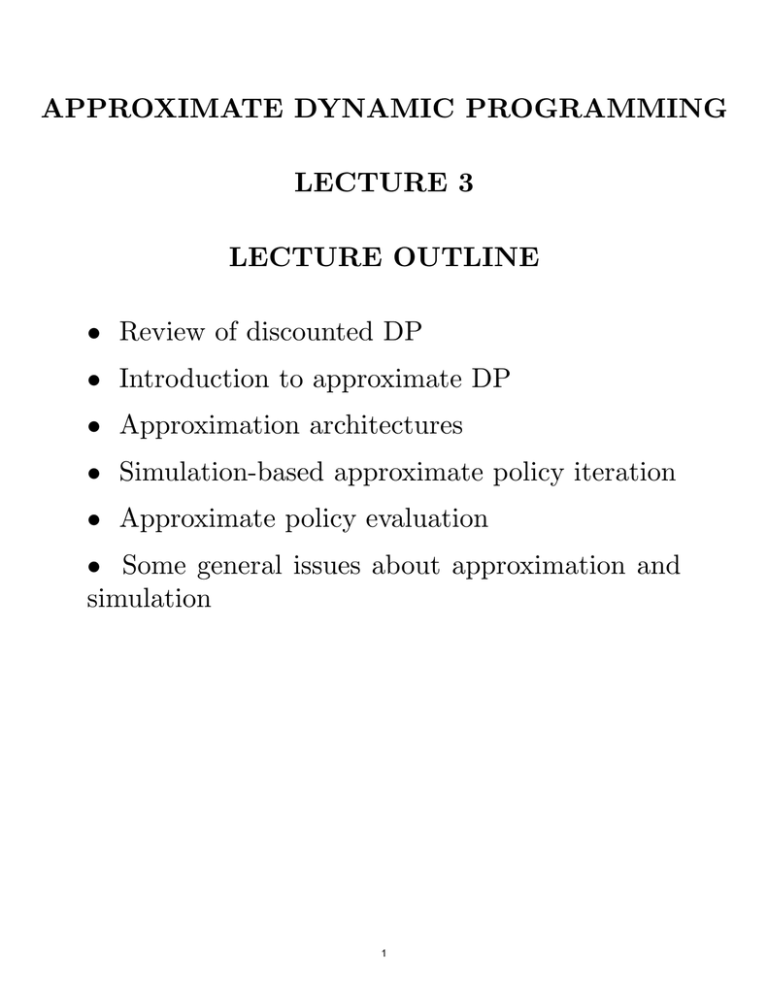
APPROXIMATE DYNAMIC PROGRAMMING
LECTURE 3
LECTURE OUTLINE
• Review of discounted DP
• Introduction to approximate DP
• Approximation architectures
• Simulation-based approximate policy iteration
• Approximate policy evaluation
• Some general issues about approximation and
simulation
1
REVIEW
2
DISCOUNTED PROBLEMS/BOUNDED COST
• Stationary system with arbitrary state space
xk+1 = f (xk , uk , wk ),
k = 0, 1, . . .
• Cost of a policy π = {µ0 , µ1 , . . .}
N −1
Jπ (x0 ) = lim
N →∞
αk g xk , µk (xk ), wk
E
w
k
k=0,1,...
k=0
with α < 1, and for some M , we have |g(x, u, w)| ≤
M for all (x, u, w)
• Shorthand notation for DP mappings (operate
on functions of state to produce other functions)
(T J)(x) = min E g(x, u, w) + αJ f (x, u, w)
u∈U (x) w
, ∀x
T J is the optimal cost function for the one-stage
problem with stage cost g and terminal cost αJ
• For any stationary policy µ
(Tµ J)(x) = E g x, µ(x), w + αJ f (x, µ(x), w)
w
3
, ∀x
MDP - TRANSITION PROBABILITY NOTATION
• We will mostly assume the system is an n-state
(controlled) Markov chain
• We will often switch to Markov chain notation
− States i = 1, . . . , n (instead of x)
− Transition probabilities pik ik+1 (uk ) [instead
of xk+1 = f (xk , uk , wk )]
− Stage cost g(ik , uk , ik+1 ) [instead of g(xk , uk , wk )]
− Cost functions J = J(1), . . . , J(n)) (vec­
tors in ℜn )
• Cost of a policy π = {µ0 , µ1 , . . .}
Jπ (i) = lim
N →∞
•
E
ik
k=1,2,...
(N −1
X
αk g
ik , µk (ik ), ik+1 | i0 = i
k=0
)
Shorthand notation for DP mappings
(T J)(i) = min
n
X
u∈U (i)
(Tµ J)(i) =
n
X
j=1
pij (u) g(i, u, j)+αJ(j)
(j) , i = 1, . . . , n,
j=1
j=1
pij µ(i)
g i, µ(i), j +αJ(j) , i = 1, . . . , n
4
“SHORTHAND” THEORY – A SUMMARY
• Bellman’s equation: J ∗ = T J ∗ , Jµ = Tµ Jµ or
J ∗ (i)
= min
Jµ (i) =
pij (u)
∀i
pij
ij µ(i) g i, µ(i), j + αJµ (j) ,
∀i
j=1
j=1
•
g(i, u, j) + αJ ∗ (j)
,
u∈U (i)
n
X
n
X
Optimality condition:
µ: optimal
<==>
Tµ J ∗ = T J ∗
i.e.,
µ(i) ∈ arg min
u∈U (i)
n
X
pij (u)
j=1
5
g(i, u, j)+αJ ∗ (j)
, ∀i
THE TWO MAIN ALGORITHMS: VI AND PI
•
Value iteration: For any J ∈ ℜn
J ∗ (i) = lim (T k J)(i),
∀ i = 1, . . . , n
k→∞
•
Policy iteration: Given µk
− Policy evaluation: Find Jµk by solving
Jµk (i) =
n
X
k
pij µ (i)
()
j=1
k
g i, µ (i), j +αJµk (j) , i = 1, . . . , n
or Jµk = Tµk Jµk
− Policy improvement: Let µk+1 be such that
µ
k+1
(i) ∈ arg min
u∈U (i)
n
X
pij (u) g(i, u, j)+αJµk (j) , ∀ i
j=1
or Tµk+1 Jµk = T Jµk
• Policy evaluation is equivalent to solving an
n × n linear system of equations
• For large n, exact PI is out of the question. We
use instead optimistic PI (policy evaluation with
a few VIs)
6
APPROXIMATE DP
7
GENERAL ORIENTATION TO ADP
• ADP (late 80s - present) is a breakthrough
methodology that allows the application of DP to
problems with many or infinite number of states.
• Other names for ADP are:
− “reinforcement learning” (RL).
− “neuro-dynamic programming” (NDP).
− “adaptive dynamic programming” (ADP).
• We will mainly adopt an n-state discounted
model (the easiest case - but think of HUGE n).
• Extensions to other DP models (continuous
space, continuous-time, not discounted) are possi­
ble (but more quirky). We will set aside for later.
• There are many approaches:
− Problem approximation
− Simulation-based approaches (we will focus
on these)
• Simulation-based methods are of three types:
− Rollout (we will not discuss further)
− Approximation in value space
− Approximation in policy space
8
WHY DO WE USE SIMULATION?
• One reason: Computational complexity advan­
tage in computing sums/expectations involving a
very large number of terms
− Any sum
n
X
ai
i=1
can be written as an expected value:
n
X
ai =
i=1
n
X
ξi
i=1
ai
= Eξ
ξi
�
ai
ξi
�
,
where ξ is any prob. distribution over {1, . . . , n}
− It can be approximated by generating many
samples {i1 , . . . , ik } from {1, . . . , n}, accord­
ing to distribution ξ, and Monte Carlo aver­
aging:
n
X
i=1
a i = Eξ
�
ai
ξi
�
k
X
1
a it
≈
k t=1 ξit
• Simulation is also convenient when an analytical
model of the system is unavailable, but a simula­
tion/computer model is possible.
9
APPROXIMATION IN VALUE AND
POLICY SPACE
10
APPROXIMATION IN VALUE SPACE
• Approximate J ∗ or Jµ from a parametric class
˜ r) where i is the current state and r = (r1 , . . . , rm )
J(i;
is a vector of “tunable” scalars weights
• Use J˜ in place of J ∗ or Jµ in various algorithms
and computations
• Role of r: By adjusting r we can change the
“shape” of J˜ so that it is “close” to J ∗ or Jµ
• Two key issues:
− The choice of parametric class J˜(i; r) (the
approximation architecture)
− Method for tuning the weights (“training”
the architecture)
• Success depends strongly on how these issues
are handled ... also on insight about the problem
• A simulator may be used, particularly when
there is no mathematical model of the system (but
there is a computer model)
• We will focus on simulation, but this is not the
only possibility
• We may also use parametric approximation for
Q-factors or cost function differences
11
APPROXIMATION ARCHITECTURES
• Divided in linear and nonlinear [i.e., linear or
nonlinear dependence of J˜(i; r) on r]
• Linear architectures are easier to train, but non­
linear ones (e.g., neural networks) are richer
•
Computer chess example:
− Think of board position as state and move
as control
− Uses a feature-based position evaluator that
assigns a score (or approximate Q-factor) to
each position/move
Feature
Extraction
Features:
Material balance,
Mobility,
Safety, etc
Weighting
of Features
Score
Position Evaluator
• Relatively few special features and weights, and
multistep lookahead
12
LINEAR APPROXIMATION ARCHITECTURES
• Often, the features encode much of the nonlin­
earity inherent in the cost function approximated
• Then the approximation may be quite accurate
without a complicated architecture (as an extreme
example, the ideal feature is the true cost func­
tion)
• With well-chosen features, we can use a linear
architecture: J˜(i; r) = φ(i)′ r, i = 1, . . . , n, or
s
X
˜ = Φr =
J(r)
Φj rj
j=1
Φ: the matrix whose rows are φ(i)′ , i = 1, . . . , n,
Φj is the jth column of Φ
i) Linear Cost
Feature
Extraction
Mapping
Feature
Vector
φ(i)
Linear
Cost
Approximator
φ(i)′ r
State
i i Feature
Extraction Mapping Feature Vectori) Linear Cost
Approximator
Approximator
)
Feature
Extraction( Mapping
Feature Vector
Feature Extraction Mapping Feature Vector
• This is approximation on the subspace
S = {Φr | r ∈ ℜs }
spanned by the columns of Φ (basis functions)
• Many examples of feature types: Polynomial
approximation, radial basis functions, etc
13
ILLUSTRATIONS: POLYNOMIAL TYPE
• Polynomial Approximation, e.g., a quadratic
approximating function. Let the state be i =
(i1 , . . . , iq ) (i.e., have q “dimensions”) and define
φ0 (i) = 1, φk (i) = ik , φkm (i) = ik im ,
k, m = 1, . . . , q
Linear approximation architecture:
˜ r) = r0 +
J(i;
q
X
rk ik +
k=1
q
q
X
X
rkm ik im ,
k=1 m=k
where r has components r0 , rk , and rkm .
• Interpolation: A subset I of special/representative
states is selected, and the parameter vector r has
one component ri per state i ∈ I. The approxi­
mating function is
˜ r) = ri ,
J(i;
i ∈ I,
˜ r) = interpolation using the values at i ∈ I, i ∈
J(i;
/ I
For example, piecewise constant, piecewise linear,
more general polynomial interpolations.
14
A DOMAIN SPECIFIC EXAMPLE
•
Tetris game (used as testbed in competitions)
......
TERMINATION
• J ∗ (i): optimal score starting from position i
• Number of states > 2200 (for 10 × 20 board)
• Success with just 22 features, readily recognized
by tetris players as capturing important aspects of
the board position (heights of columns, etc)
15
APPROX. PI - OPTION TO APPROX. Jµ OR Qµ
• Use simulation to approximate the cost Jµ of
the current policy µ
• Generate “improved” policy µ by minimizing in
(approx.) Bellman equation
Initial Policy Controlled System Cost per Stage Vector
tion Matrix ( )
Evaluate Approximate Cost Steady­State
Distribution
Approximate
Policy
˜
Cost ( i,) u, r) Jµ (i, r)
Evaluation
Generate “Improved” Policy µ
Policy Improvement
• Altenatively approximate the Q-factors of µ
Initial Policy Controlled System Cost per Stage Vector
tion Matrix ( )
Evaluate Approximate Q­Factors Approximate Policy
Approximate
(i, u, r)Evaluation
Q̃µPolicy
Evaluation
Generate “Improved” Policy µ
µ(i) = arg minu∈U (i) Q̃µ (i, u, r)
Initial state (
) Time
oximate Policy Evaluation
16
Policy Improvement
APPROXIMATING J ∗ OR Q∗
• Approximation of the optimal cost function J ∗
− Q-Learning: Use a simulation algorithm to
approximate the Q-factors
Q∗ (i, u) = g(i, u) + α
n
X
pij (u)J ∗ (j);
j=1
and the optimal costs
J ∗ (i) = min Q∗ (i, u)
u∈U (i)
− Bellman Error approach: Find r to
min Ei
r
�
J˜(i; r) − (T J˜)(i; r)
2 �
where Ei {·} is taken with respect to some
distribution over the states
− Approximate Linear Programming (we will
not discuss here)
• Q-learning can also be used with approxima­
tions
• Q-learning and Bellman error approach can also
be used for policy evaluation
17
APPROXIMATION IN POLICY SPACE
• A brief discussion; we will return to it later.
• Use parametrization µ(i; r) of policies with a
vector r = (r1 , . . . , rs ). Examples:
− Polynomial, e.g., µ(i; r) = r1 + r2 · i + r3 · i2
− Linear feature-based
µ(i; r) = φ1 (i) · r1 + φ2 (i) · r2
• Optimize the cost over r. For example:
− Each value of r defines a stationary policy,
with cost starting at state i denoted by J˜(i; r).
− Let (p1 , . . . , pn ) be some probability distri­
bution over the states, and minimize over r
n
X
˜ r)
pi J(i;
i=1
− Use a random search, gradient, or other method
• A special case: The parameterization of the
policies is indirect, through a cost approximation
architecture Jˆ, i.e.,
n
X
µ(i; r) ∈ arg min
pij (u) g(i, u, j) + αJˆ(j; r)
u∈U (i)
j=1
18
APPROXIMATE POLICY EVALUATION
METHODS
19
DIRECT POLICY EVALUATION
• Approximate the cost of the current policy by
using least squares and simulation-generated cost
samples
• Amounts to projection of Jµ onto the approxi­
mation subspace
Direct Method: Projection of cost vector Jµ Π
µ
ΠJµ
=0
Subspace S = {Φr | r ∈ ℜs } Set
Direct Method: Projection of cost vector
( )cost (vector
)
(Jµ)
ct Method: Projection of
• Solution by least squares methods
• Regular and optimistic policy iteration
• Nonlinear approximation architectures may also
be used
20
DIRECT EVALUATION BY SIMULATION
• Projection by Monte Carlo Simulation: Com­
pute the projection ΠJµ of Jµ on subspace S =
{Φr | r ∈ ℜs }, with respect to a weighted Eu­
clidean norm I · Iξ
• Equivalently, find Φr∗ , where
r∗
= arg mins
r∈ℜ
IΦr−Jµ I2ξ
= arg mins
r∈ℜ
r∗ ,
n
X
i=1
2
′
ξi φ(i) r−Jµ (i)
• Setting to 0 the gradient at
!−1 n
n
X
X
r∗ =
ξi φ(i)φ(i)′
ξi φ(i)Jµ (i)
i=1
i=1
• Generate samples (i1 , Jµ (i1 )), . . . , (ik , Jµ (ik ))
using distribution ξ
• Approximate by Monte Carlo the two “expected
values” with low-dimensional calculations
!−1 k
k
X
X
′
r̂k =
φ(it )φ(it )
φ(it )Jµ (it )
t=1
t=1
• Equivalent least squares alternative calculation:
r̂k = arg mins
r∈ℜ
k
X
φ(it
t=1
21
)′ r
− Jµ (it )
2
INDIRECT POLICY EVALUATION
• An example: Galerkin approximation
• Solve the projected equation Φr = ΠTµ (Φr)
where Π is projection w/ respect to a suitable
weighted Euclidean norm
Tµ (Φr)
Direct Method: Projection of cost vector Jµ Π
µ
Φr = ΠTµ (Φr)
ΠJµ
=0
Subspace S = {Φr | r ∈ ℜs } Set
=0
Subspace S = {Φr | r ∈ ℜs } Set
Direct Method: Projection of cost vector
Indirect Method: Solving a projected form of Be
( )cost (vector
)Indirect
(Jµ) Method: Solving a projected form
jection of
Projection
on
of Bellman’s
equation
• Solution methods that use simulation (to man­
age the calculation of Π)
− TD(λ): Stochastic iterative algorithm for solv­
ing Φr = ΠTµ (Φr)
− LSTD(λ): Solves a simulation-based approx­
imation w/ a standard solver
− LSPE(λ): A simulation-based form of pro­
jected value iteration; essentially
Φrk+1 = ΠTµ (Φrk ) + simulation noise
22
BELLMAN EQUATION ERROR METHODS
• Another example of indirect approximate policy
evaluation:
min IΦr − Tµ (Φr)I2ξ
r
(∗)
where I · Iξ is Euclidean norm, weighted with re­
spect to some distribution ξ
• It is closely related to the projected equation/Galerkin
approach (with a special choice of projection norm)
• Several ways to implement projected equation
and Bellman error methods by simulation. They
involve:
− Generating many random samples of states
ik using the distribution ξ
− Generating many samples of transitions (ik , jk )
using the policy µ
− Form a simulation-based approximation of
the optimality condition for projection prob­
lem or problem (*) (use sample averages in
place of inner products)
− Solve the Monte-Carlo approximation of the
optimality condition
• Issues for indirect methods: How to generate
the samples? How to calculate r∗ efficiently?
23
ANOTHER INDIRECT METHOD: AGGREGATION
• A first idea: Group similar states together into
“aggregate states” x1 , . . . , xs ; assign a common
cost value ri to each group xi .
• Solve an “aggregate” DP problem, involving the
aggregate states, to obtain r = (r1 , . . . , rs ). This
is called hard aggregation
1
1 2 3 4 15 26 37 48 59 16 27 38 49 5 6 7 8 9 ⎜ 1
⎜
⎜0
⎜
1 2 3 4 5 6 7 8 9 x1
x2
⎜1
⎜
1 2 3 4 15 26 37 48 59 16 27 38 49 5 6 7 8 9
Φ = ⎜1
⎜
⎜0
⎜
1 2 3 4 15 26 37 48 x
59316 27 38 49 5 6x74 8 9
⎜0
⎝
0
0
⎛
0
0
1
0
0
1
0
0
0
0
0
0
0
0
0
1
1
0
⎞
0
0⎟
⎟
0⎟
⎟
0⎟
⎟
0⎟
⎟
0⎟
⎟
0⎟
⎠
0
1
• More general/mathematical view: Solve
Φr = ΦDTµ (Φr)
where the rows of D and Φ are prob. distributions
(e.g., D and Φ “aggregate” rows and columns of
the linear system J = Tµ J)
• Compare with projected equation Φr = ΠTµ (Φr).
Note: ΦD is a projection in some interesting cases
24
AGGREGATION AS PROBLEM APPROXIMATION
!
Original System States Aggregate States
Original System States Aggregate States
j=1
,
i
!
!
u, j)
according to pij (u),, g(i,
with
cost
Matrix Matrix Aggregation Probabilities
Disaggregation Probabilities
Probabilities Probabilities
Aggregation Disaggregation
Aggregation Probabilities
Disaggregation
!
φjyProbabilities
Q
Disaggregation Probabilities
dxi !
|
|
|
S
Aggregate States
Original
System
States
Original
System
States
Original
System
States
), x
), y
n
n
�
�
pij (u)φjy ,
p̂xy (u) =
dxi
i=1
ĝ(x, u) =
n
�
dxi
i=1
j=1
n
�
pij (u)g(i, u, j)
j=1
• Aggregation can be viewed as a systematic
approach for problem approximation. Main ele­
ments:
− Solve (exactly or approximately) the “ag­
gregate” problem by any kind of VI or PI
method (including simulation-based methods)
− Use the optimal cost of the aggregate prob­
lem to approximate the optimal cost of the
original problem
• Because an exact PI algorithm is used to solve
the approximate/aggregate problem the method
behaves more regularly than the projected equa­
tion approach
25
APPROXIMATE POLICY ITERATION
ISSUES
26
THEORETICAL BASIS OF APPROXIMATE PI
• If policies are approximately evaluated using an
approximation architecture such that
max |J˜(i, rk ) − Jµk (i)| ≤ δ,
i
k = 0, 1, . . .
• If policy improvement is also approximate,
max |(Tµk+1 J˜)(i, rk )−(T J˜)(i, rk )| ≤ ǫ,
i
k = 0, 1, . . .
• Error bound: The sequence {µk } generated by
approximate policy iteration satisfies
lim sup max Jµk (i) −
k→∞
i
J ∗ (i)
ǫ + 2αδ
≤
(1 − α)2
• Typical practical behavior: The method makes
steady progress up to a point and then the iterates
Jµk oscillate within a neighborhood of J ∗ .
• Oscillations are quite unpredictable.
− Some bad examples of oscillations have been
constructed.
− In practice oscillations between policies is
probably not the major concern.
27
THE ISSUE OF EXPLORATION
• To evaluate a policy µ, we need to generate cost
samples using that policy - this biases the simula­
tion by underrepresenting states that are unlikely
to occur under µ
• Cost-to-go estimates of underrepresented states
may be highly inaccurate
• This seriously impacts the improved policy µ
• This is known as inadequate exploration - a
particularly acute difficulty when the randomness
embodied in the transition probabilities is “rela­
tively small” (e.g., a deterministic system)
• Some remedies:
− Frequently restart the simulation and ensure
that the initial states employed form a rich
and representative subset
− Occasionally generate transitions that use a
randomly selected control rather than the
one dictated by the policy µ
− Other methods: Use two Markov chains (one
is the chain of the policy and is used to gen­
erate the transition sequence, the other is
used to generate the state sequence).
28
APPROXIMATING Q-FACTORS
• Given J˜(i; r), policy improvement requires a
model [knowledge of pij (u) for all controls u ∈
U (i)]
• Model-free alternative: Approximate Q-factors
Q̃(i, u; r) ≈
n
X
pij (u) g(i, u, j) + αJµ (j)
j=1
and use for policy improvement the minimization
˜ u; r)
µ(i) ∈ arg min Q(i,
u∈U (i)
• r is an adjustable parameter vector and Q̃(i, u; r)
is a parametric architecture, such as
s
X
Q̃(i, u; r) =
rm φm (i, u)
m=1
• We can adapt any of the cost approximation
approaches, e.g., projected equations, aggregation
• Use the Markov chain with states (i, u), so
pij (µ(i)) is the transition prob. to (j, µ(i)), 0 to
other (j, u′ )
• Major concern: Acutely diminished exploration
29
SOME GENERAL ISSUES
30
STOCHASTIC ALGORITHMS: GENERALITIES
• Consider solution of a linear equation x = b +
Ax by using m simulation samples b + wk and
A + Wk , k = 1, . . . , m, where wk , Wk are random,
e.g., “simulation noise”
• Think of x = b + Ax as approximate policy
evaluation (projected or aggregation equations)
• Stoch. approx. (SA) approach: For k = 1, . . . , m
xk+1 = (1 − γk )xk + γk (b + wk ) + (A + Wk )xk
• Monte Carlo estimation (MCE) approach: Form
Monte Carlo estimates of b and A
m
bm
m
1 X
=
(b + wk ),
m
Am
k=1
1 X
=
(A + Wk )
m
k=1
Then solve x = bm + Am x by matrix inversion
xm = (1 − Am )−1 bm
or iteratively
• TD(λ) and Q-learning are SA methods
• LSTD(λ) and LSPE(λ) are MCE methods
31
COSTS OR COST DIFFERENCES?
• Consider the exact policy improvement process.
To compare two controls u and u′ at x, we need
E g(x, u, w) −
g(x, u′ , w)
′
+ α Jµ (x) − Jµ (x )
where x = f (x, u, w) and x′ = f (x, u′ , w)
• Approximate Jµ (x) or
Dµ (x, x′ ) = Jµ (x) − Jµ (x′ )?
• Approximating Dµ (x, x′ ) avoids “noise differ­
encing”. This can make a big difference
• Important point: Dµ satisfies a Bellman equa­
tion for a system with “state” (x, x′ )
Dµ
(x, x′ )
= E Gµ
(x, x′ , w)
′
+ αDµ (x, x )
where x = f x, µ(x), w , x = f
Gµ
(x, x′ , w))
′
x′ , µ(x′ ), w
= g x, µ(x), w − g
and
x′ , µ(x′ ), w
• Dµ can be “learned” by the standard methods
(TD, LSTD, LSPE, Bellman error, aggregation,
etc). This is known as differential training.
32
AN EXAMPLE (FROM THE NDP TEXT)
• System and cost per stage:
g(x, u) = δ(x2 + u2 )
xk+1 = xk + δuk ,
δ > 0 is very small; think of discretization of
continuous-time problem involving dx(t)/dt = u(t)
• Consider policy µ(x) = −2x. Its cost function
is
5x2
Jµ (x) =
(1 + δ) + O(δ 2 )
4
and its Q-factor is
5x2
Qµ (x, u) =
+δ
4
9x2
5
2
+ u + xu + O(δ 2 )
4
2
• The important part for policy improvement is
δ
u2
5
+ xu
2
When Jµ (x) [or Qµ (x, u)] is approximated by
J˜µ (x; r) [or by Q̃µ (x, u; r)], it will be dominated
2
by 5x4 and will be “lost”
33
MIT OpenCourseWare
http://ocw.mit.edu
6.231 Dynamic Programming and Stochastic Control
Fall 2015
For information about citing these materials or our Terms of Use, visit: http://ocw.mit.edu/terms.
